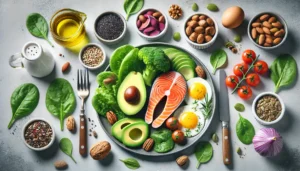
The ketogenic (keto) diet is a scientifically backed, low-carb, high-fat eating plan designed to shift your body into ketosis, a metabolic state where fat replaces glucose as your primary energy source. This guide answers all critical questions for beginners, offering actionable steps, expert insights, and science-based explanations to ensure success.
1. What is a Keto Diet?
The keto diet is a macronutrient-focused plan that drastically reduces carbohydrate intake (5-10% of calories), prioritizes healthy fats (70-75%), and includes moderate protein (20-25%). Unlike low-fat diets, keto emphasizes fat consumption to fuel the body, mimicking the metabolic effects of fasting.
Key Macronutrient Ratios:
- Fats: Avocado, olive oil, coconut oil, butter, fatty fish.
- Proteins: Eggs, poultry, grass-fed meat, tofu (for plant-based).
- Carbs: Leafy greens, broccoli, cauliflower (20-50g net carbs daily).
2. What Happens to Your Body on a Keto Diet?
- Days 1-3: Your body depletes glycogen (stored glucose), causing water weight loss.
- Days 4-7: With glycogen exhausted, your liver converts fat into ketones, entering ketosis.
- Long-Term: Insulin levels drop, fat-burning accelerates, and mental clarity improves due to stable energy from ketones.
3. How Does a Keto Diet Work?
Carb restriction forces your body to seek alternative energy sources. The liver breaks down fat into ketones, which replace glucose to power the brain, heart, and muscles. This metabolic shift suppresses hunger hormones (e.g., ghrelin) and enhances fat oxidation.
Science Simplified:
- Low carbs → Low insulin → Fat released from cells.
- Fat → Ketones → Energy for organs.
4. What is Ketosis?
Ketosis is a natural metabolic state where the body burns fat instead of carbs for fuel. It typically begins 2-7 days after reducing carbs to ≤50g daily. Optimal ketone levels for health benefits range from 0.5-3.0 mmol/L (measured via blood, urine, or breath tests).
Triggers for Ketosis:
- Carb restriction (<50g net daily).
- Intermittent fasting (16+ hours without food).
- Exercise (depletes glycogen faster).
5. What Do I Eat on a Keto Diet?

Approved Foods:
- Proteins: Beef, chicken, salmon, eggs, tofu.
- Fats: Olive oil, avocado, butter, nuts (macadamias, almonds).
- Vegetables: Spinach, kale, zucchini, asparagus (low-carb options).
- Dairy: Full-fat cheese, heavy cream, unsweetened yogurt.
Sample Daily Meal Plan:
- Breakfast: Scrambled eggs with spinach and avocado.
- Lunch: Grilled chicken salad with olive oil dressing.
- Dinner: Salmon with roasted broccoli and cauliflower rice.
- Snack: Celery sticks with almond butter.
6. Foods to Avoid on Keto
- Grains: Wheat, rice, oats, quinoa.
- Sugars: Sodas, candy, desserts, hidden sugars (ketchup, sauces).
- Starchy Vegetables: Potatoes, corn, peas.
- High-Carb Fruits: Bananas, grapes, mangoes.
- Processed Foods: Chips, crackers, frozen meals.
Pro Tip: Check labels for added sugars (e.g., dextrose, maltose).
7. Benefits of a Ketogenic Diet
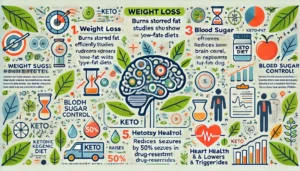
- Weight Loss: Burns stored fat efficiently; studies show keto outperforms low-fat diets.
- Blood Sugar Control: Reduces HbA1c levels, aiding Type 2 diabetes management.
- Mental Clarity: Ketones provide steady brain fuel, reducing brain fog.
- Epilepsy Management: Reduces seizures by 50% in drug-resistant cases.
- Heart Health: Raises HDL cholesterol and lowers triglycerides.
8. How Do I Reach Ketosis?
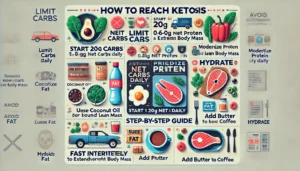
Step-by-Step Guide:
- Limit Carbs: Start with 20g net carbs daily.
- Moderate Protein: 0.6-0.8g per pound of lean body mass (e.g., 70g protein for a 150lb person).
- Prioritize Fat: Cook with coconut oil, snack on olives, add butter to coffee.
- Hydrate: Drink 3-4 liters of water daily.
- Fast Intermittently: Skip breakfast to extend overnight fasting.
Avoid Pitfalls:
- Overeating protein (triggers gluconeogenesis).
- Ignoring electrolytes (sodium, potassium, magnesium).
9. How Do I Know If I’m in Ketosis?
Physical Signs:
- Keto Breath: Fruity or metallic taste from acetone production.
- Increased Energy: Stable energy without afternoon crashes.
- Appetite Suppression: Reduced hunger due to regulated ghrelin.
Testing Methods:
- Urine Strips: Affordable but less accurate over time.
- Blood Ketone Meters: Precise but costly (1−3 per test).
- Breath Analyzers: Reusable devices measuring acetone.
10. What Are Macros on a Keto Diet?
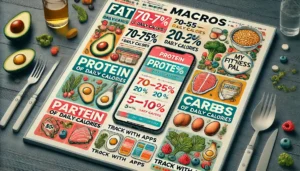
Macronutrients (macros) are the foundation of keto:
- Fat: 70-75% of calories (e.g., 150g fat for a 2,000-calorie diet).
- Protein: 20-25% (e.g., 100g protein daily).
- Carbs: 5-10% (20-50g net carbs).
Track with Apps:
- MyFitnessPal: Log meals and scan barcodes.
- Carb Manager: Customizes macros based on goals.
11. Types of Ketogenic Diets
- Standard Keto (SKD): Classic plan with strict carb limits.
- Targeted Keto (TKD): Adds 20-30g carbs pre-workout for athletes.
- Cyclical Keto (CKD): 5 keto days + 2 high-carb days (for bodybuilders).
12. Keto and Physical Performance
- Short-Term: Strength and endurance may dip during the 2-4 week adaptation phase.
- Long-Term: Improved endurance as the body efficiently burns fat.
Athlete Tip: Use TKD to fuel intense workouts with minimal carb intake.
13. Dangers of a Keto Diet
- Ketoacidosis: Rare (except in Type 1 diabetics); caused by extreme ketone buildup.
- Nutrient Deficiencies: Low magnesium or vitamin D if vegetables are neglected.
- Social Challenges: Dining out requires careful menu choices.
Prevention:
- Monitor ketone levels if diabetic.
- Eat diverse, nutrient-dense foods.
14. What is Keto Flu, and How Do I Avoid It?
Symptoms: Fatigue, headaches, nausea, and irritability during the first week.
Remedies:
- Electrolytes:
- Sodium: 5,000mg daily (add salt to meals).
- Potassium: 3,500mg (avocado, spinach).
- Magnesium: 400mg (supplements or pumpkin seeds).
- Hydration: Drink bone broth or electrolyte mixes.
- Rest: Prioritize 7-8 hours of sleep.
15. Common Side Effects
- Leg Cramps: Low magnesium; supplement or eat leafy greens.
- Constipation: Increase fiber (chia seeds, flaxseeds) and water.
- Temporary Hair Loss: Stress-induced telogen effluvium; resolves in 3-6 months.
16. Less Common Side Effects
- Gallstones: Rapid fat intake may trigger existing issues; increase fat gradually.
- Keto Rash: Red, itchy patches (treat with antifungal cream or carb tweaks).
- Indigestion: Digestive enzymes or apple cider vinegar before meals.
17. Keto for Weight Loss
Why It Works:
- Lowers insulin, reducing fat storage.
- Suppresses appetite via ketones and protein.
- Burns stored fat for energy.
Average Loss: 1-2 lbs/week after initial water weight (5-10 lbs in Week 1).
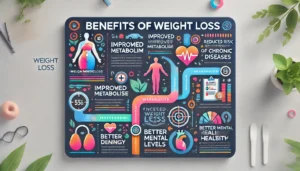
18. Keto and Blood Sugar
Studies show keto reduces fasting glucose and HbA1c by 1-2% in Type 2 diabetics. Always consult a doctor before starting.
19. Mental Focus on Keto
Ketones cross the blood-brain barrier, providing efficient energy. Users report improved concentration, memory, and reduced brain fog.
20. Energy Levels on Keto
Fat provides 9 calories per gram (vs. 4 for carbs), offering sustained energy without sugar crashes.
21. Keto and Epilepsy
Used since the 1920s, keto reduces seizures by 50% in children. Work with a neurologist for medical supervision.
22. Cholesterol and Blood Pressure
- HDL Rises: Protects against heart disease.
- Triglycerides Drop: Linked to reduced inflammation.
- Blood Pressure: Often improves with weight loss.
23. Insulin Resistance
Keto lowers insulin levels, improving sensitivity. A 2020 study found 75% of participants reversed prediabetes on keto.
24. Keto and Acne
Reduced sugar intake decreases IGF-1 (a hormone linked to breakouts). Dairy may worsen acne for some—opt for dairy-free keto if needed.
25. Keto While Breastfeeding
Safety: Possible but monitor milk supply. Increase carbs to 30-50g daily and calories by 300-500. Consult a healthcare provider.
26. Hair Loss on Keto
Temporary shedding due to stress or nutrient gaps. Biotin and collagen supplements may help.
27. Keto and Gallstones
Risk increases if transitioning from a low-fat diet. Introduce fats slowly and drink lemon water to support bile production.
28. Indigestion on Keto
Fix:
- Take digestive enzymes.
- Eat smaller, frequent meals.
- Avoid greasy foods initially.
29. Keto Rash
Causes: Ketones in sweat or fungal overgrowth.
Solutions:
- Wash sweat off immediately.
- Apply antifungal creams.
- Increase carbs slightly (5-10g).
30. Weight Loss Expectations
- Week 1: 5-10 lbs (water weight).
- Weeks 2+: 1-2 lbs/week (fat loss).
Plateaus: Recalculate macros every 10 lbs lost.
31. Tracking Carb Intake
Net Carbs = Total Carbs – Fiber – Sugar Alcohols. Use apps like Cronometer for accuracy.
32. Cheating on Keto
Effects:
- Exits ketosis for 24-48 hours.
- Triggers cravings and water retention.
Recovery: Resume keto, fast intermittently, and exercise to re-enter ketosis faster.
33. Stalled Weight Loss
Solutions:
- Track macros strictly.
- Eliminate hidden carbs (e.g., sauces).
- Try a 24-hour fast.
34. Plant-Based Keto
Protein Sources: Tempeh, seitan, hemp seeds.
Fats: Coconut oil, avocado, olives.
Recipes: Zucchini noodles with vegan pesto, chia pudding.
35. Post-Goal Weight Maintenance
- Keto Maintenance: Increase carbs to 50-100g net daily.
- Low-Carb Lifestyle: Stay under 100g carbs to avoid regain.
36. Budget-Friendly Keto
- Buy frozen veggies and bulk meats.
- Use canned fish (sardines, tuna).
- Meal prep casseroles or soups.
37. Best Keto Recipes
- Cauliflower Crust Pizza: Mix riced cauliflower, cheese, and egg.
- Avocado Chocolate Mousse: Blend avocado, cocoa powder, and stevia.
- Bacon-Wrapped Asparagus: Bake at 400°F for 15 minutes.
38. Calculating Macros
Formula:
- BMR (Basal Metabolic Rate): Use the Mifflin-St Jeor equation.
- Activity Level: Multiply BMR by 1.2-1.9.
- Macro Split: 70% fat, 25% protein, 5% carbs.
Use a Keto Calculator: Input age, weight, and goals for personalized macros.
39. Best Keto Snacks
- Savory: Cheese crisps, pepperoni slices.
- Sweet: Dark chocolate (90%+), raspberries with whipped cream.
40. Managing Keto Flu
Quick Fix:
- 1 tsp salt + ½ tsp NoSalt (potassium) in water.
- Magnesium glycinate before bed.
41. Essential Supplements
- Electrolytes: Sodium, potassium, magnesium.
- Omega-3s: Fish oil for heart health.
- MCT Oil: Boosts ketone production.
42. Exercise and Muscle Building
- Strength Training: Preserves muscle mass; aim for 3x weekly.
- Protein Intake: 1.0-1.2g per pound of lean mass for muscle gain.
43. Best Keto Vegetables
| Vegetable | Net Carbs per 100g |
|---|---|
| Spinach | 1.4g |
| Broccoli | 4.0g |
| Cauliflower | 3.0g |
| Zucchini | 2.1g |
Final Tips for Success
- Meal Prep: Plan weekly meals to avoid carb temptations.
- Community Support: Join keto forums or social media groups.
- Patience: Allow 4-6 weeks for full adaptation.
By following this guide, beginners can confidently navigate keto, optimize health, and achieve sustainable results. Always consult a healthcare provider before starting, especially with pre-existing conditions.
Ready to Start? Download a free 7-day keto meal plan [here] and join thousands who’ve transformed their health!